Enhanced Low-Frequency Sound Absorption of a Porous Layer Mosaicked with Perforated Resonator
Abstract
:1. Introduction
2. Models and Methods
2.1. Theoretical Model of PPCS
2.2. Numerical Model of PPCS
2.3. Experimental Validation
3. Results and Discussion
3.1. Sound Absorption Mechanism of PPCS
3.2. Comparison of Sound Absorption between PPCS and Other Structures
3.3. Influence of Parameters on Sound Absorption of PPCS
4. Conclusions
- (1)
- The PR filled with porous material in the back cavity is conducive to excite coupled modes and to achieve a high sound absorption in a wide frequency band, and this proposed structure is a broadband acoustic metamaterial. In the frequency range below the quarter-wavelength resonance, the samples with thicknesses of 30 mm and 40 mm have sound absorption coefficients greater than 0.6 in 700–2830 Hz and 425–2125 Hz, respectively. Both demonstrate effective absorption in bandwidths more than two octaves.
- (2)
- The proposed composite structure has acoustic performance equivalent to the classical MPP and can be used as an alternative to the MPP for low–mid frequency sound absorption. In the specific frequency range of 200–2000 Hz, for a space thickness of 40 mm, the optimal average sound absorption coefficients of the structure with hole diameter of 5.1 mm and the MPP with hole diameter of 0.3 mm are 0.81 and 0.67, respectively; for a space thickness of 30 mm, the optimal average sound absorption coefficients of the structure with hole diameter of 5.5 mm and the MPP with hole diameter of 0.3 mm are 0.64 and 0.65, respectively.
- (3)
- The result of parameter analysis shows that the hole diameter, the thickness of porous material in the cavity of PR, and the area occupancy ratio have significant effects on the sound absorption characteristics of the proposed structure, especially at low frequencies, while the flow resistance of the porous material has a mild effect on the sound absorption characteristics.
Author Contributions
Funding
Institutional Review Board Statement
Informed Consent Statement
Data Availability Statement
Acknowledgments
Conflicts of Interest
References
- Sagartzazu, X.; Hervella-Nieto, L.; Pagalday, J.M. Review in Sound Absorbing Materials. Arch. Comput. Methods Eng. 2008, 15, 311–342. [Google Scholar] [CrossRef]
- Yang, M.; Sheng, P. Sound Absorption Structures: From Porous Media to Acoustic Metamaterials. Annu. Rev. Mater. Res. 2017, 47, 83–114. [Google Scholar] [CrossRef]
- Leitao, C.; Qiuxia, F.; Yang, S.; Bin, D.; Jianyong, Y. Porous materials for sound absorption. Compos. Commun. 2018, 10, 25–35. [Google Scholar]
- Bolt, R.H. On the Design of Perforated Facings for Acoustic Materials. J. Acoust. Soc. Am. 1947, 19, 917–921. [Google Scholar] [CrossRef]
- Ingard, U.; Bolt, R.H. Absorption Characteristics of Acoustic Material with Perforated Facings. J. Acoust. Soc. Am. 1951, 23, 533–540. [Google Scholar] [CrossRef]
- Callaway, B.D. The Use of Perforated Facings in Designing Low Frequency Resonant Absorbers. J. Acoust. Soc. Am. 1952, 24, 309–312. [Google Scholar] [CrossRef]
- Davern, W.A. Perforated facings backed with porous materials as sound absorbers—An experimental study. Appl. Acoust. 1977, 10, 85–112. [Google Scholar] [CrossRef]
- Maa, D.Y. Theory and design of microperforated panel sound absorbing constructions. Sci. China Ser. A 1975, xviii, 55–71. [Google Scholar]
- Maa, D.Y. Microperforated-panel wideband absorbers. Noise Control Eng. J. 1987, 29, 77–84. [Google Scholar] [CrossRef]
- Nocke, C.; Hilge, C.; Scherrer, J.M. Sound absorbers with micro-perforated stretched foils and porous materials. J. Acoust. Soc. Am. 2005, 117, 2556. [Google Scholar] [CrossRef]
- Nocke, C.; Hilge, C.; Scherrer, J.-M. Micro-perforated sound absorbers in stretched materials. In Proceedings of the ACOUSTTICS, Gold Coast, Australia, 2–4 November 2012; pp. 92–94. [Google Scholar]
- Sakagami, K.; Kobatake, S.; Kano, K.I.; Morimoto, M.; Yairi, M. Sound absorption characteristics of a single microperforated panel absorber backed by a porous absorbent layer. Acoust. Aust. 2011, 39, 95–100. [Google Scholar]
- Li, D.; Chang, D.; Liu, B.; Tian, J. Improving sound absorption bandwidth of micro-perforated panel by adding porous materials. In Proceedings of the INTER-NOISE and NOISE-CON Congress and Conference Proceedings, Melbourne, Australia, 16–19 November 2014; pp. 1877–1882. [Google Scholar]
- Li, D.; Chang, D.; Liu, B. Enhanced low- to mid-frequency sound absorption using parallel-arranged perforated plates with extended tubes and porous material. Appl. Acoust. 2017, 127, 316–323. [Google Scholar] [CrossRef]
- Li, D.; Chang, D.; Liu, B. Diffuse Sound Absorptive Properties of Parallel-Arranged Perforated Plates with Extended Tubes and Porous Materials. Materials 2020, 13, 1091. [Google Scholar] [CrossRef] [PubMed] [Green Version]
- Xin, L.A.; Bl, A.; Dc, B. An acoustic impedance structure consisting of perforated panel resonator and porous material for low-to-mid frequency sound absorption. Appl. Acoust. 2021, 180, 108069. [Google Scholar]
- Li, D.; Jiang, Z.; Li, L.; Liu, X.; He, M. Investigation of Acoustic Properties on Wideband Sound-Absorber Composed of Hollow Perforated Spherical Structure with Extended Tubes and Porous Materials. Appl. Sci. 2020, 10, 8978. [Google Scholar] [CrossRef]
- Boutin, C.; Royer, P.; Auriault, J. Acoustic absorption of porous surfacing with dual porosity. Int. J. Solids Struct. 1998, 35, 4709–4737. [Google Scholar] [CrossRef] [Green Version]
- Olny, X.; Boutin, C. Acoustic wave propagation in double porosity media. J. Acoust. Soc. Am. 2003, 114, 73–89. [Google Scholar] [CrossRef]
- Sgard, F.C.; Olny, X.; Atalla, N.; Castel, F. On the use of perforations to improve the sound absorption of porous materials. Appl. Acoust. 2005, 66, 625–651. [Google Scholar] [CrossRef]
- Xin, F.; Ma, X.; Liu, X.; Zhang, C. A multiscale theoretical approach for the sound absorption of slit-perforated double porosity materials. Compos. Struct. 2019, 223, 110919. [Google Scholar] [CrossRef]
- Liu, X.; Yu, C.; Xin, F. Gradually perforated porous materials backed with Helmholtz resonant cavity for broadband low-frequency sound absorption. Compos. Struct. 2021, 263, 113647. [Google Scholar] [CrossRef]
- Zhao, H.; Wang, Y.; Yu, D.; Yang, H.; Wen, J. A double porosity material for low frequency sound absorption. Compos. Struct. 2020, 239, 111978. [Google Scholar] [CrossRef]
- Liu, Q.; Liu, X.; Zhang, C.; Xin, F. A novel multiscale porous composite structure for sound absorption enhancement. Compos. Struct. 2021, 276, 114456. [Google Scholar] [CrossRef]
- Groby, J.P.; Dazel, O.; Duclos, A.; Boeckx, L.; Kelders, L. Enhancing the absorption coefficient of a backed rigid frame porous layer by embedding circular periodic inclusions. J. Acoust. Soc. Am. 2011, 130, 3771–3780. [Google Scholar] [CrossRef] [Green Version]
- Boutin, C. Acoustics of porous media with inner resonators. J. Acoust. Soc. Am. 2013, 134, 4717. [Google Scholar] [CrossRef]
- Lagarrigue, C.; Groby, J.P.; Tournat, V.; Dazel, O.; Umnova, O. Absorption of sound by porous layers with embedded periodic arrays of resonant inclusions. J. Acoust. Soc. Am. 2013, 134, 4670. [Google Scholar] [CrossRef]
- Groby, J.P.; Lagarrigue, C.; Brouard, B.; Dazel, O.; Tournat, V.; Nennig, B. Using simple shape three-dimensional inclusions to enhance porous layer absorption. J. Acoust. Soc. Am. 2014, 136, 1139–1148. [Google Scholar] [CrossRef] [PubMed] [Green Version]
- Boutin, C.; Becot, F.X. Theory and experiments on poro-acoustics with inner resonators. Wave Motion 2015, 54, 76–99. [Google Scholar] [CrossRef]
- Groby, J.P.; Lagarrigue, C.; Brouard, B.; Dazel, O.; Tournat, V.; Nennig, B. Enhancing the absorption properties of acoustic porous plates by periodically embedding Helmholtz resonators. J. Acoust. Soc. Am. 2015, 137, 273. [Google Scholar] [CrossRef] [PubMed] [Green Version]
- Zhu, X.-F.; Lau, S.-K.; Lu, Z.; Jeon, W. Broadband low-frequency sound absorption by periodic metamaterial resonators embedded in a porous layer. J. Sound Vib. 2019, 461, 114922. [Google Scholar] [CrossRef]
- Rv, A.; Tgz, B.; Gn, A.; Fxb, C. Acoustics of porous composites. Compos. Part B Eng. 2021, 220, 109006. [Google Scholar]
- Wang, Y.; Wang, Y.; Xu, J.; Yu, H.; Zhang, C.; Ren, L. Broadband low-frequency sound absorption by coiled-up space embedded in a porous layer. Appl. Acoust. 2021, 182, 108226. [Google Scholar] [CrossRef]
- Boulvert, J.; Cavalieri, T.; Costa-Baptista, J.; Schwan, L.; Romero-García, V.; Gabard, G.; Fotsing, E.R.; Ross, A.; Mardjono, J.; Groby, J.-P. Optimally graded porous material for broadband perfect absorption of sound. J. Appl. Phys. 2019, 126, 175101. [Google Scholar] [CrossRef]
- Cavalieri, T.; Boulvert, J.; Gabard, G.; Romero-García, V.; Escouflaire, M.; Regnard, J.; Groby, J.-P. Graded and anisotropic porous materials for broadband and angular maximal acoustic absorption. Materials 2020, 13, 4605. [Google Scholar] [CrossRef] [PubMed]
- Boulvert, J.; Costa-Baptista, J.; Cavalieri, T.; Romero-García, V.; Gabard, G.; Fotsing, E.R.; Ross, A.; Perna, M.; Mardjono, J.; Groby, J.-P. Folded metaporous material for sub-wavelength and broadband perfect sound absorption. Appl. Phys. Lett. 2020, 117, 251902. [Google Scholar] [CrossRef]
- Cavalieri, T.; Boulvert, J.; Romero-García, V.; Gabard, G.; Groby, J.P. Rapid additive manufacturing of optimized anisotropic metaporous surfaces for broadband absorption. J. Appl. Phys. 2021, 129, 115102. [Google Scholar] [CrossRef]
- Allard, J.F.; Champoux, Y. New empirical equations for sound propagation in rigid frame fibrous materials. J. Acoust. Soc. Am. 1992, 91, 3346–3353. [Google Scholar] [CrossRef]
- Atalla, Y.; Panneton, R. Inverse acoustical characterization of open cell porous media using impedance tube measurements. Can. Acoust. 2005, 33, 11–24. [Google Scholar]
- Johnson, D.L.; Koplik, J.; Dashen, R. Theory of dynamic permeability and tortuosity in fluid-saturated porous media. J. Fluid Mech. 1987, 176, 379–402. [Google Scholar] [CrossRef]
- Champoux, Y.; Allard, J.F. Dynamic tortuosity and bulk modulus in air-saturated porous media. J. Appl. Phys. 1991, 70, 1975–1979. [Google Scholar] [CrossRef]
- ISO(10534-2); Acoustics–Determination of Sound Absorption Coefficient and Impedance in Impedance Tubes–Part 2: Transfer-Function Method. International Organization for Standardization: Geneva, Switzerland, 2001.
- Hao, M.; Wen, J.; Zhao, H.; Wen, X. Optimization of locally resonant acoustic metamaterials on underwater sound absorption characteristics. J. Sound Vib. 2012, 331, 4406–4416. [Google Scholar]
- Luo, Y.; Lou, J.J.; Zhang, Y.B.; Li, J.R. Sound-Absorption Mechanism of Structures with Periodic Cavities. Acoust. Aust. 2021, 49, 371–383. [Google Scholar] [CrossRef]
- Chang, Y.C.; Yeh, L.J.; Chiu, M.C.; Lai, G.J. Shape optimization on constrained single-layer sound absorber by using GA method and mathematical gradient methods. J. Sound Vib. 2005, 286, 941–961. [Google Scholar] [CrossRef]
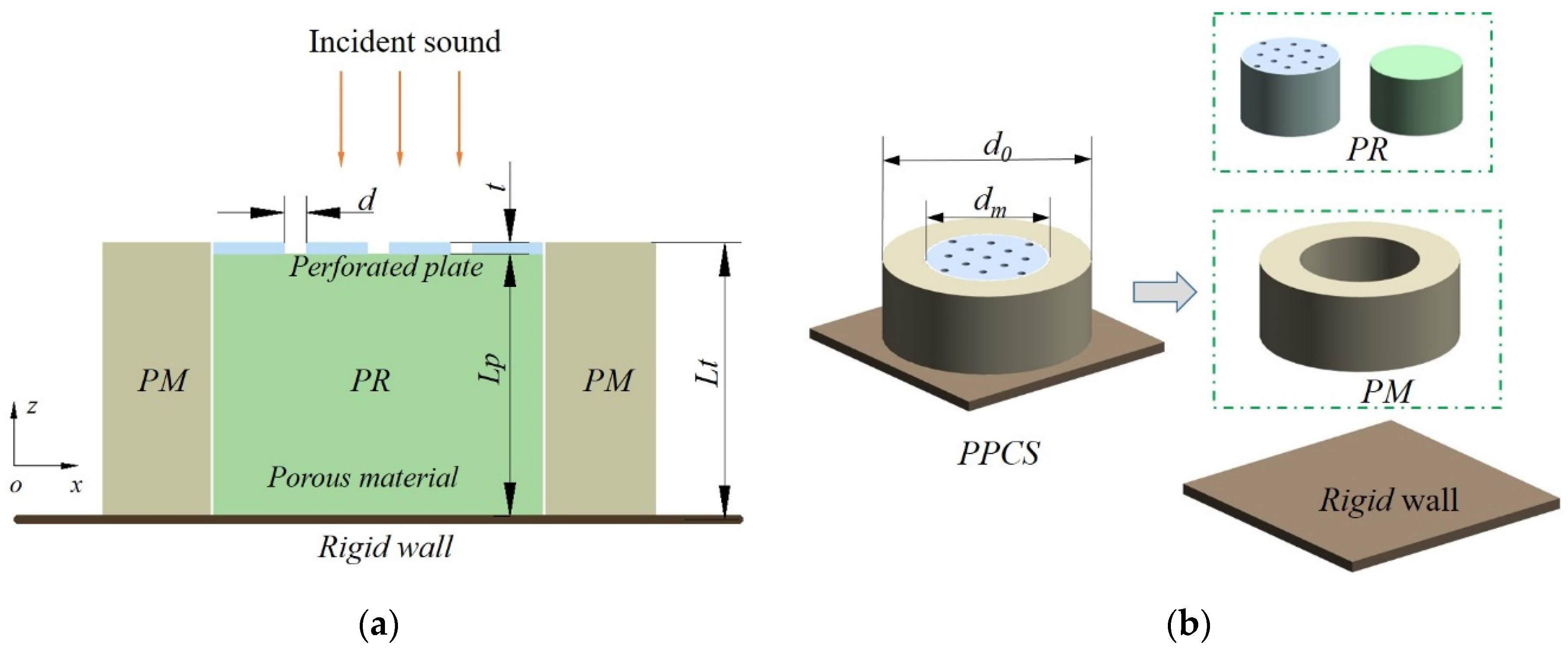
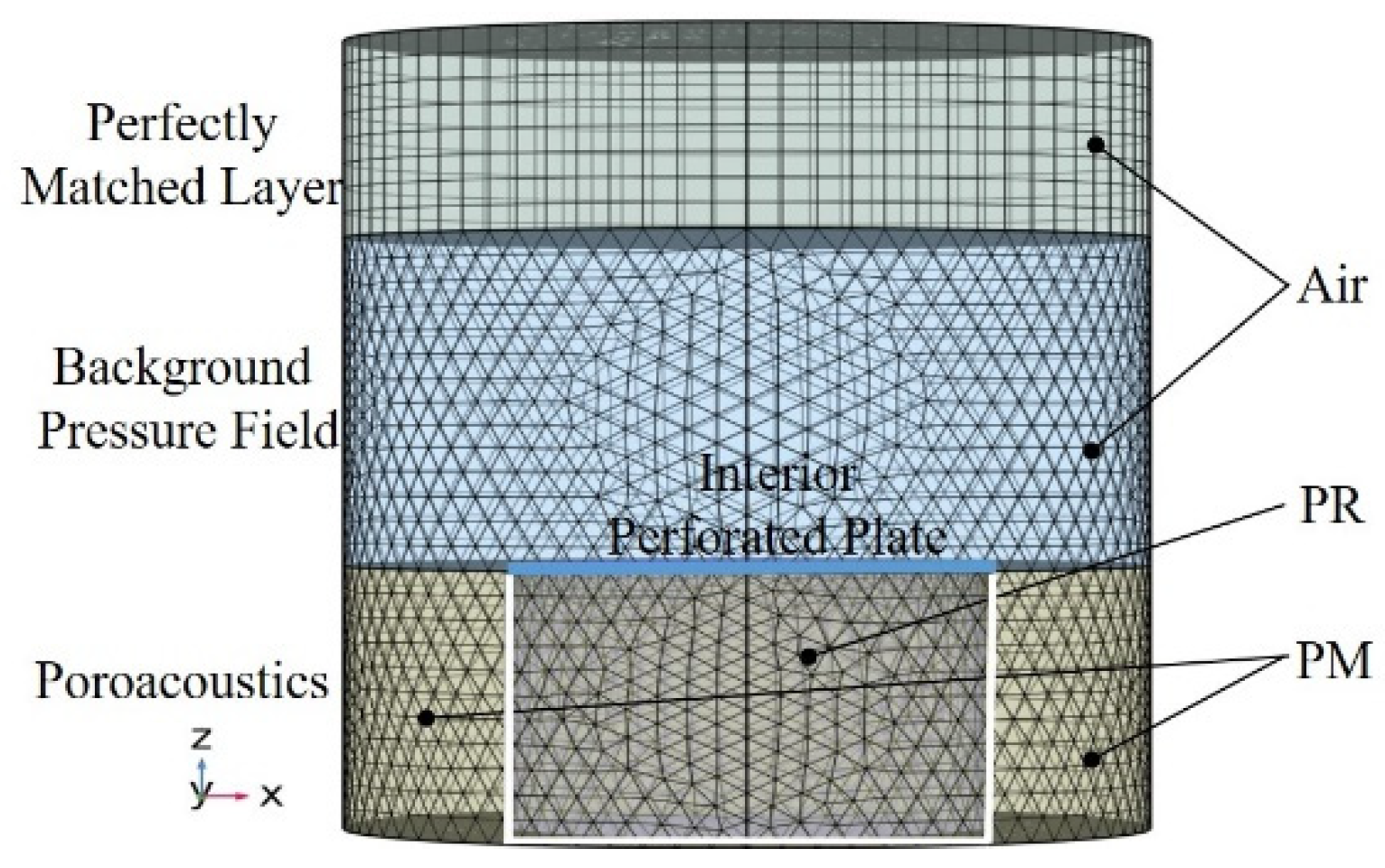

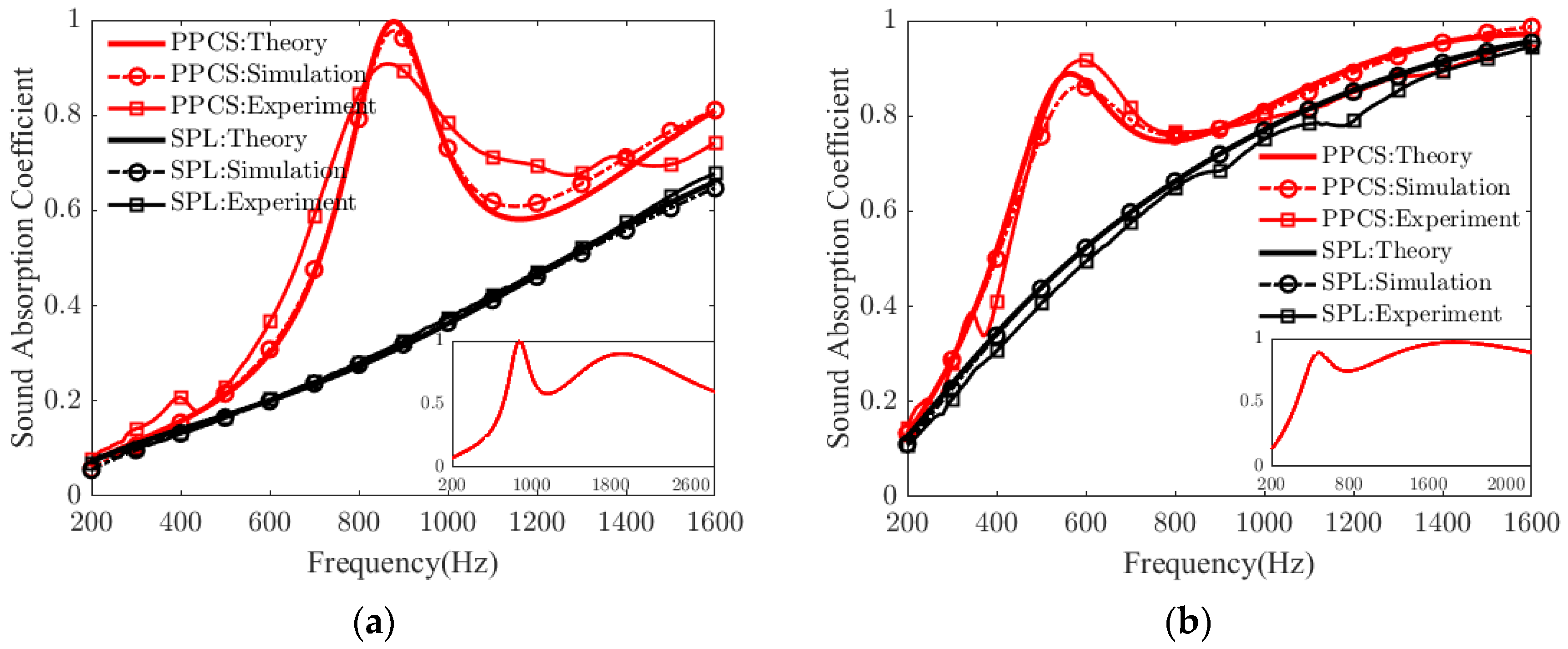
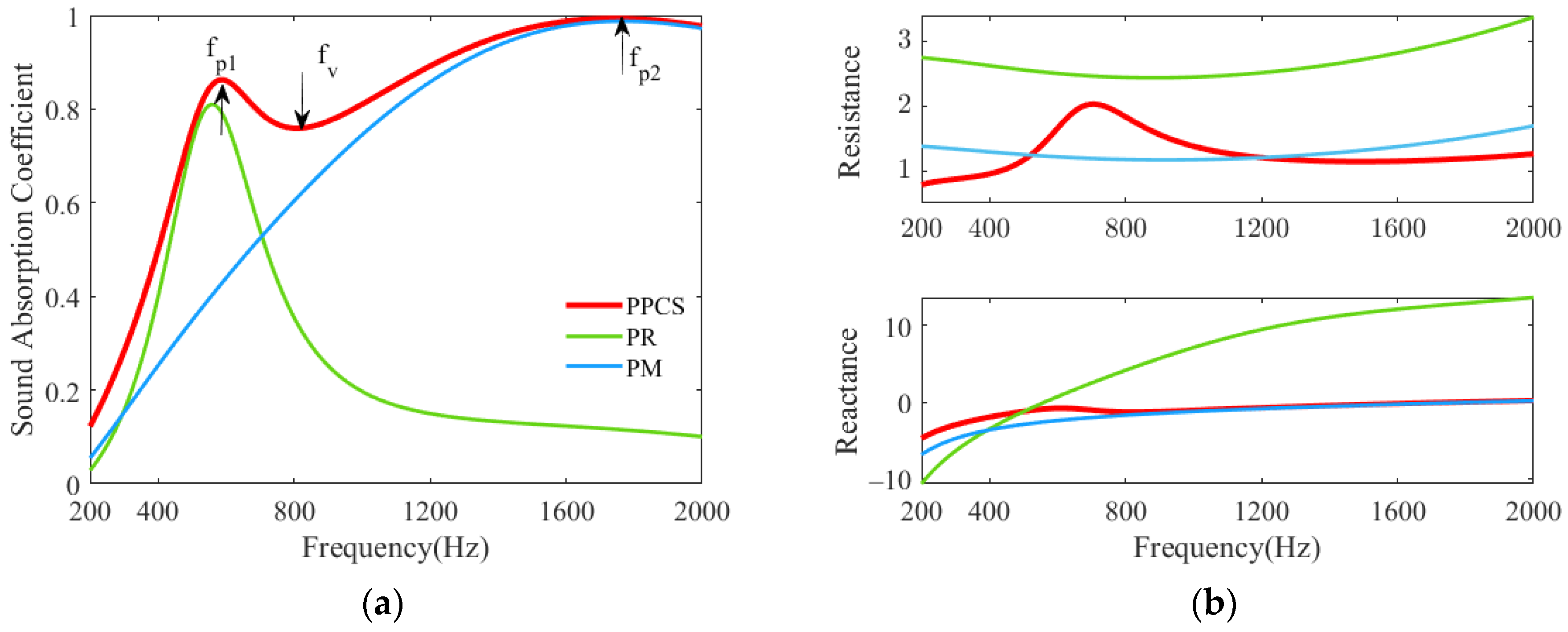
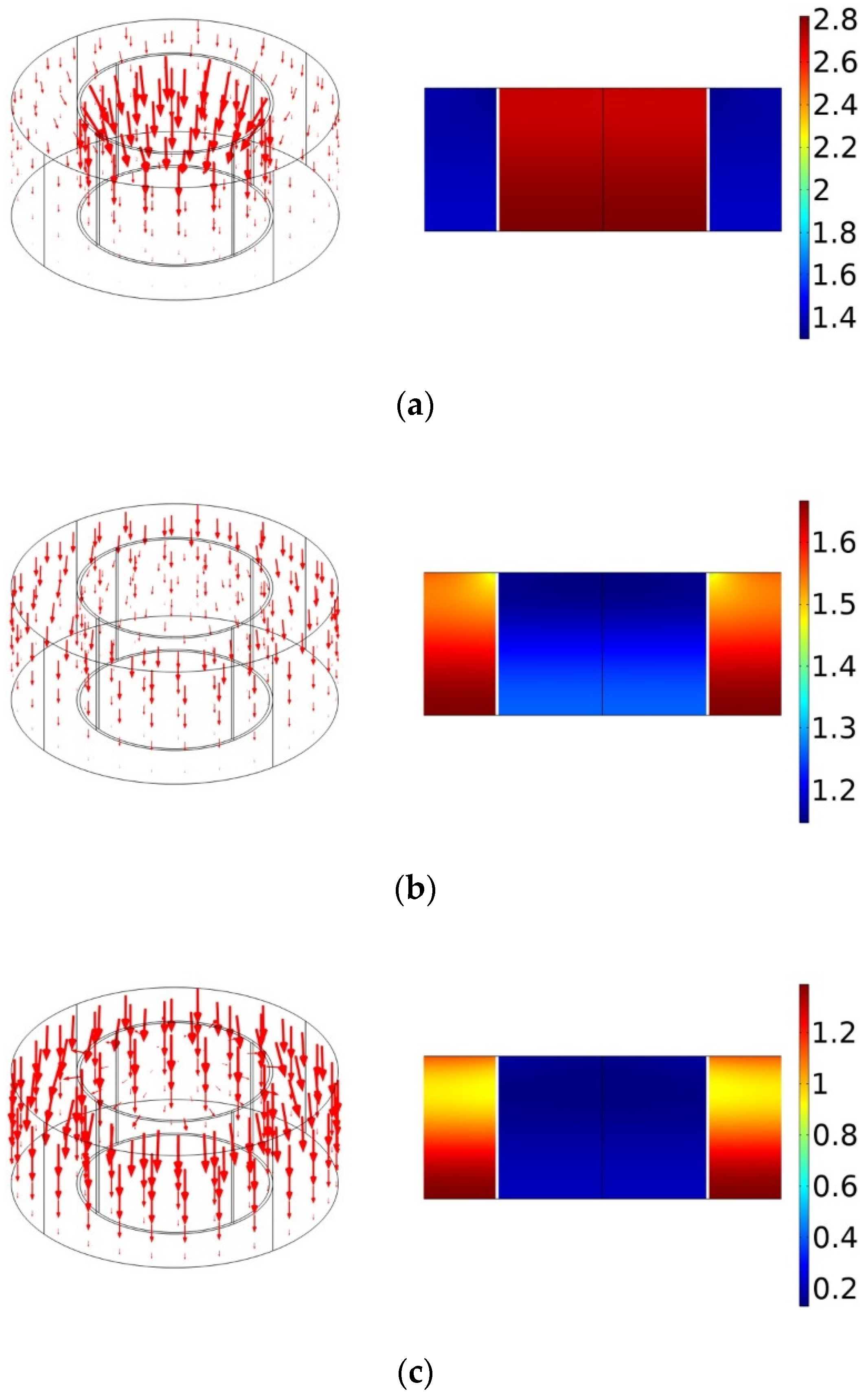
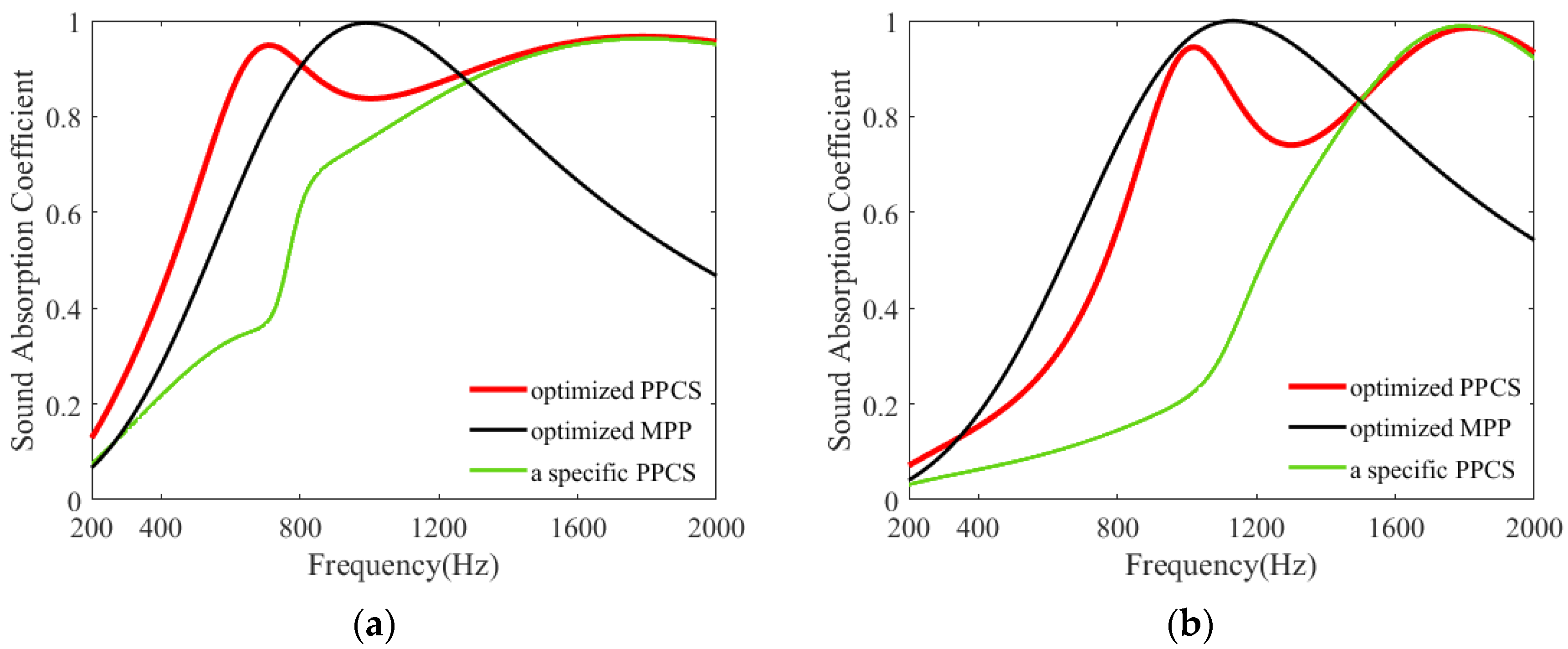


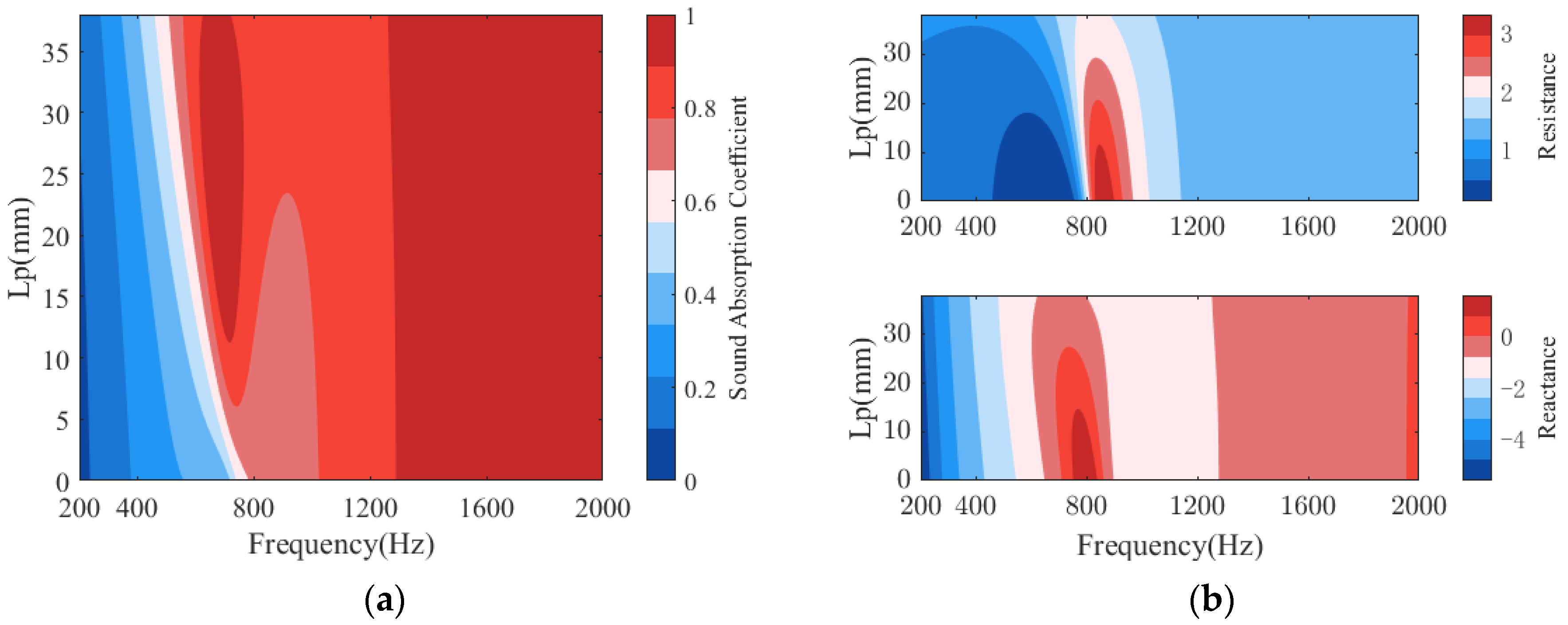
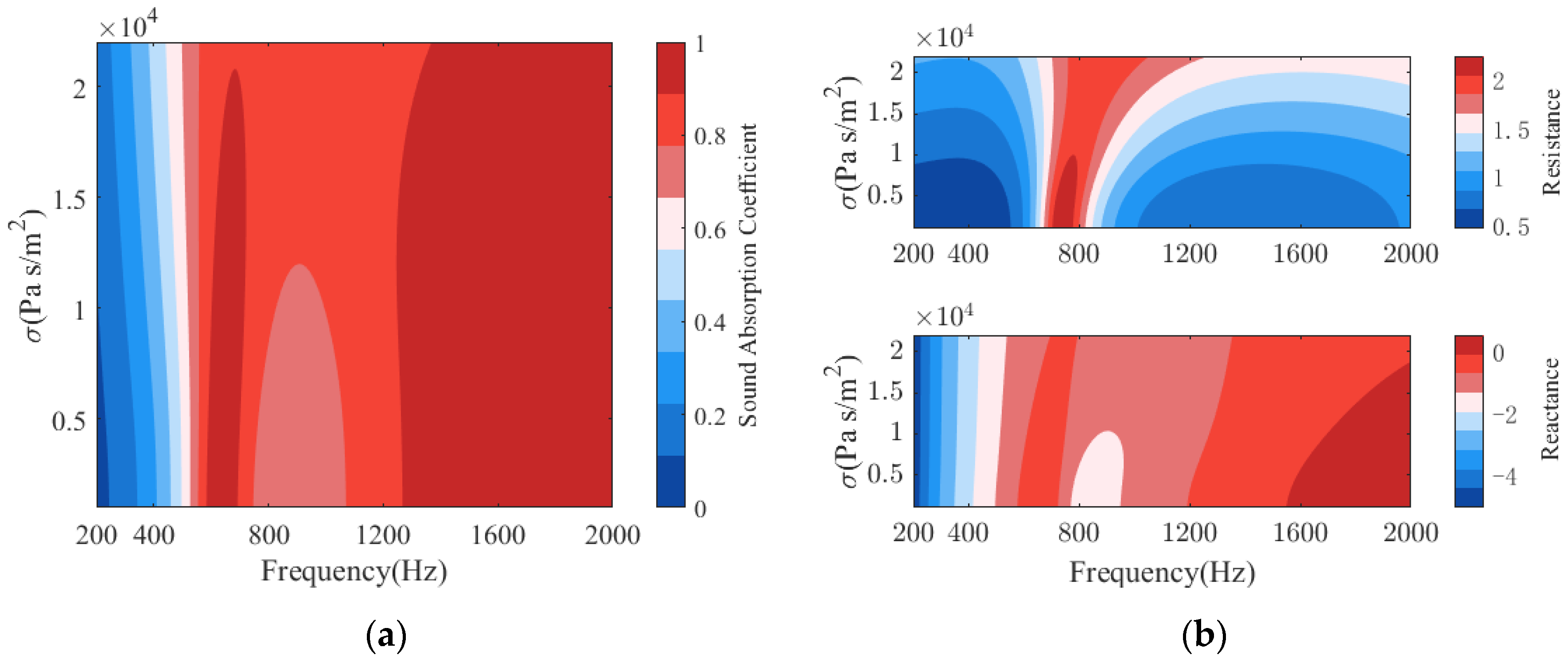
| Porous-Material Layer of Polyurethane | |||||
|---|---|---|---|---|---|
| (%) | Ʌ (μm) | Ʌ′ (μm) | L (mm) | ||
| 2156 | 0.98 | 179 | 318 | 1.1 | 40 |
| d (mm) | t (mm) | p (%) | d0 (mm) | dm (mm) | tp (mm) |
| 3.6 | 2 | 1.56 | 100 | 58 | 1 |
| Porous-Material Layer of Melamine | |||||
| (%) | Ʌ (μm) | Ʌ′ (μm) | L (mm) | ||
| 15,734 | 0.99 | 92 | 197 | 1.04 | 40 |
| d (mm) | t (mm) | p (%) | d0 (mm) | dm (mm) | tp (mm) |
| 4 | 2 | 0.96 | 100 | 58 | 1 |
| Thickness: 40 mm | d (mm) | p (%) | APR (%) | t (mm) |
|---|---|---|---|---|
| PPCS | 5.1 | 2.08 | 41.5 | 2 |
| MPP | 0.3 | 4.50 | - | 2 |
| Thickness: 30 mm | d (mm) | p (%) | APR (%) | t (mm) |
| PPCS | 5.5 | 4.54 | 55.4 | 2 |
| MPP | 0.3 | 4.15 | - | 2 |
Publisher’s Note: MDPI stays neutral with regard to jurisdictional claims in published maps and institutional affiliations. |
© 2022 by the authors. Licensee MDPI, Basel, Switzerland. This article is an open access article distributed under the terms and conditions of the Creative Commons Attribution (CC BY) license (https://creativecommons.org/licenses/by/4.0/).
Share and Cite
Li, X.; Liu, B.; Wu, Q. Enhanced Low-Frequency Sound Absorption of a Porous Layer Mosaicked with Perforated Resonator. Polymers 2022, 14, 223. https://doi.org/10.3390/polym14020223
Li X, Liu B, Wu Q. Enhanced Low-Frequency Sound Absorption of a Porous Layer Mosaicked with Perforated Resonator. Polymers. 2022; 14(2):223. https://doi.org/10.3390/polym14020223
Chicago/Turabian StyleLi, Xin, Bilong Liu, and Qianqian Wu. 2022. "Enhanced Low-Frequency Sound Absorption of a Porous Layer Mosaicked with Perforated Resonator" Polymers 14, no. 2: 223. https://doi.org/10.3390/polym14020223
APA StyleLi, X., Liu, B., & Wu, Q. (2022). Enhanced Low-Frequency Sound Absorption of a Porous Layer Mosaicked with Perforated Resonator. Polymers, 14(2), 223. https://doi.org/10.3390/polym14020223





